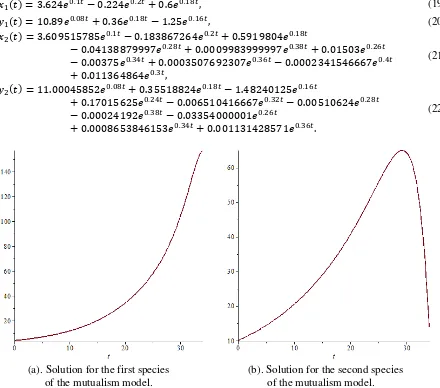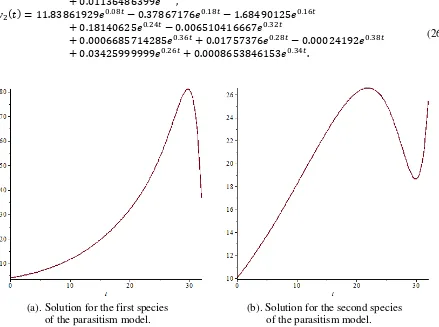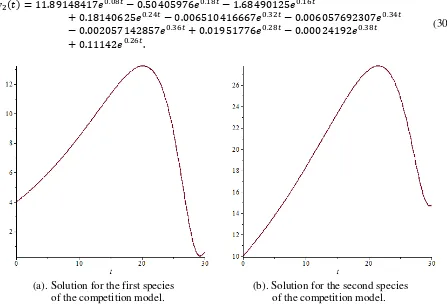This content has been downloaded from IOPscience. Please scroll down to see the full text.
Download details:
IP Address: 202.94.83.84
This content was downloaded on 11/02/2017 at 06:17
Please note that terms and conditions apply.
Variational iteration method for solving the population dynamics model of two species
View the table of contents for this issue, or go to the journal homepage for more
Variational iteration method for solving the population
dynamics model of two species
Benedictus Dwi Yuliyanto1 and Sudi Mungkasi2 1
Postgraduate Program in Mathematics Education, Faculty of Teacher Training and Education, Sanata Dharma University, Yogyakarta, Indonesia
2
Department of Mathematics, Faculty of Science and Technology, Sanata Dharma University, Yogyakarta, Indonesia
E-mail: [email protected], [email protected]
Abstract. This paper applies the variational iteration method for solving systems of nonlinear ordinary differential equations. The model under consideration in this work is the population dynamics model of two species. Our results show that the variational iteration method provides formulas to approximate the exact solution at every time value with a very cheap computation.
1. Introduction
Systems of differential equations do not only have important roles in mathematics, but they also play essential roles in other fields of study, such as economics, physics, biology, computer sciences etc. [1-3]. Furthermore, non-linear phenomena often occurs in real problems. A system of non-linear ordinary differential equations are ordinary differential equations which satisfy that the unknown functions only rely on one independent variable and fulfill at least one of the following requirements: consists of dependent variables and/or derivatives to the power of except one, contains multiplication of dependent variable and/or its derivatives.
In biology, differential equations occur in the model of population growth. This paper solves systems of non-linear ordinary differential equations. In particluar, we solve the population dynamics model of two species with the variational iteration method.
Variational iteration method has been a well-known technique to solve mathematical equations [4-9]. It is an analytical approach to solving differential equations. Its greatest advantages are that the method is meshless, the solution is an explicit function, and the iterations are convergent to the exact solution very rapidly. Readers interested in other type of meshless method are referred to the Adomian decomposition method [10-12].
The paper is written in the following structure. In Section 2, we write the population dynamics model, which is the problem that we want to solve. The variational iteration method to solve the model is presented in Section 3. Computational results are provided in Section 4. We conclude the paper with some remarks in Section 5.
2. Population dynamics model
This section provides the general form of the model of the population dynamics of two species:
= + + , (1)
ICSAS IOP Publishing IOP Conf. Series: Journal of Physics: Conf. Series 795(2017) 012044 doi:10.1088/1742-6596/795/1/012044
Content from this work may be used under the terms of theCreative Commons Attribution 3.0 licence. Any further distribution of this work must maintain attribution to the author(s) and the title of the work, journal citation and DOI.
= + + , (2) where:
• represents the population of the first species, • represents the population of the second species,
• is constant denoting the intrinsic growth rate of species , • is constant denoting the intrinsic growth rate of species ,
• is constant denoting the rate of the declining in growth of species due to the increase in the population of species ,
• is constant denoting the rate of the declining in growth of species due to the increase in the population of species ,
• is constant denoting the growth rate of the species due to interaction with species , • is constant denoting the growth rate of the species due to interaction with species . The free variable is time . A predator and prey model related to equations (1)-(2) can be found in the work of Sharma and Samanta [13].
3. Variation iteration method
Variational iteration method consists of three basic concepts, that is: the correction functionals, the restricted variations, and the Lagrange multipliers. For the variational iteration method, in this section we follow the work of Batiha et al. [4]. Details of the original method can be found in the work of method can be established and analysed using a correction functional as follows:
= + + − (4) IOP Conf. Series: Journal of Physics: Conf. Series 795(2017) 012044 doi:10.1088/1742-6596/795/1/012044
= + $ # % # −# # − # − # # & #
The Lagrange multipliers and can be obtained by solving the following system as the
stationary conditions:
From the previous section, values of 8 and 8 can be obtained from the initial value. We assume that 0 = 4 and 0 = 10. We obtain 8 = 4 and 8 = 10. Therefore, = 4356$ and =
10357$.
In this section, we provide variational iteration solutions to examples of mutualism, parasitism, and competition of two species.
ICSAS IOP Publishing IOP Conf. Series: Journal of Physics: Conf. Series 795(2017) 012044 doi:10.1088/1742-6596/795/1/012044
4.1. Mutualism model
Below are given the solution of the system (1)-(2) the model of mutualism using the variational
iteration method. We assume that = 0.1; = 0.08; = −0.0014; = −0.001; =
0.0012; = 0.0009.
Then the variational iteration solutions up to and are as follows:
= 3.6243 . $− 0.2243 . $+ 0.63 . @$, (19)
= 10.893 . @$+ 0.363 . @$− 1.253 . B$, (20)
= 3.6095157853 . $− 0.1838672643 . $+ 0.59198043 . @$
− 0.041388799973 . @$+ 0.00099839999973 .D@$+ 0.015033 . B$
− 0.003753 .DE$+ 0.00035076923073 .DB$− 0.00023415466673 .E$
+ 0.0113648643 .D$,
(21)
= 11.000458523 . @$+ 0.355188243 . @$− 1.482401253 . B$
+ 0.170156253 . E$− 0.0065104166673 .D $− 0.005106243 . @$
− 0.000241923 .D@$− 0.033540000013 . B$
we observe that due to mutualism, populations of both species increase with respect to time at initial stages of the interaction.
4.2. Parasitism model
Below are given the solution of the system (1)-(2) for parasitism model using the variational iteration
method. We assume that = 0.1; = 0.08; = −0.0014; = −0.001; = 0.0012; =
−0.0009.
Representatives of the series of variational iteration solutions are:
= 3.6243 . $− 0.2243 . $+ 0.63 . @$, (23)
= 11.613 . @$− 0.363 . @$− 1.253 . B$, (24)
ICSAS IOP Publishing IOP Conf. Series: Journal of Physics: Conf. Series 795(2017) 012044 doi:10.1088/1742-6596/795/1/012044
= 3.5869096323 . $− 0.1838672643 . $+ 0.63111963 . @$
− 0.0016430769233 .DB$− 0.05985923 . @$+ 0.00168963 .D@$
+ 0.018273 . B$− 0.003753 .DE$− 0.00023415466673 .E$
+ 0.011364863993 .D$,
(25)
= 11.838619293 . @$− 0.378671763 . @$− 1.684901253 . B$
+ 0.181406253 . E$− 0.0065104166673 .D $
+ 0.00066857142853 .DB$+ 0.017573763 . @$− 0.000241923 .D@$
+ 0.034259999993 . B$+ 0.00086538461533 .DE$.
(26)
(a). Solution for the first species of the parasitism model.
(b). Solution for the second species of the parasitism model.
Figure 2. Graphics of solutions to the parasitism model: (a). D , (b). D with 0 ≤ ≤ 32.
Representatives of the solutions to the parasitism model are plotted in Figure 2 for D and D . In this figure we observe that due to parasitism, one of the population decreases respect to time. This then is followed by the other population. Again we do not write D and D in this paper, because the formulas are too long.
4.3. Competition model
Below are given the solution to the system (1)-(2) for the competition model using the variational
iteration method. We assume that = 0.1; = 0.08; = −0.0014; = −0.001; =
−0.0012; = −0.0009.
Representatives of the series of the variational iteration solutions are:
= 4.8243 . $− 0.2243 . $− 0.63 . @$, (27)
= 11.613 . @$− 0.363 . @$− 1.253 . B$, (28)
= 4.9892574473 . $− 0.3257936643 . $− 0.84009959993 . @$− 0.003753 .DE$
− 0.0042276923073 .DB$+ 0.073939199973 . @$− 0.00168963 .D@$
+ 0.0151280643 .D$− 0.00023415466673 .E$+ 0.097473 . B$, (29)
ICSAS IOP Publishing IOP Conf. Series: Journal of Physics: Conf. Series 795(2017) 012044 doi:10.1088/1742-6596/795/1/012044
= 11.891484173 . @$− 0.504059763 . @$− 1.684901253 . B$
+ 0.181406253 . E$− 0.0065104166673 .D $− 0.0060576923073 .DE$
− 0.0020571428573 .DB$+ 0.019517763 . @$− 0.000241923 .D@$
+ 0.111423 . B$.
(30)
(a). Solution for the first species of the competition model.
(b). Solution for the second species of the competition model.
Figure 3. Graphics of solutions to the competition model: (a). D , (b). D with 0 ≤ ≤ 30.
Representatives of the solutions to the competition model are plotted in Figure 3 for D and
D . Once again, we do not write D and D in this paper, because the formulas are too long.
For small time, both populations increase with respect to time.
Numerical computations for all three cases (mutualism, parasitism, and competition) are given in Table 1. We have compared with these results with the second order Runge-Kutta numerical method. These results are very accurate, as the discrepancy is less than 104B.
Table 1. Numerical results from the variational iteration method based on the given examples.
Mutualism model Parasitism model Competition model
0.0 4.000000000 10.00000000 4.000000000 10.00000000 4.000000000 10.00000000
0.1 4.042793029 10.07385374 4.042791267 10.06656813 4.033070759 10.06657252
0.2 4.086055587 10.14821700 4.086048406 10.13347257 4.066363553 10.13349044
0.3 4.129792919 10.22309301 4.129776450 10.20071348 4.099879151 10.20075432
0.4 4.174010333 10.29848492 4.173980487 10.26829093 4.133618314 10.26836475
0.5 4.218713190 10.37439597 4.218665655 10.33620501 4.167581809 10.33632224
0.6 4.263906918 10.45082936 4.263837141 10.40445571 4.201770394 10.40462736
0.7 4.309596990 10.52778838 4.309500171 10.47304310 4.236184811 10.47328059
0.8 4.355788954 10.60527627 4.355660046 10.54196712 4.270825824 10.54228248
0.9 4.402488408 10.68329631 4.402322086 10.61122779 4.305694169 10.61163354
1.0 4.449701012 10.76185184 4.449491688 10.68082503 4.340790588 10.68133427
ICSAS IOP Publishing IOP Conf. Series: Journal of Physics: Conf. Series 795(2017) 012044 doi:10.1088/1742-6596/795/1/012044
5. Conclusion
Based on the research that has been done, it can be concluded that the variational iteration method can be used to find the solution of the population dynamics model of two species accurately. The population dynamics model of two species being researched is a system of non-linear ordinary differential equations of the first order with initial values. The variational iteration method gives approximate solutions at every time value without any discretisation of the time domain. The iteration formulas are simple. Therefore, they are easy to compute in solving population dynamics models.
Acknowledgment
This work was financially supported by Sanata Dharma University. The financial support is gratefully acknowledged by both authors.
References
[1] Haberman R 1998 Mathematical Models Mechanical Vibrations, Population Dynamics, and Traffic Flow
(Philadelphia: SIAM)
[2] Chaibi S and Laskri M T 2014 Efficient data selection approach in projected feature space for fast training support vector machines International Journal of Business Intelligence and Data Mining 9 179
[3] Montoya O L Q, Villa L F, Muñoz S, Arenas A C R and Bastidas M 2015 Information retrieval on documents methodology based on entropy filtering methodologies International Journal of Business Intelligence and Data Mining 10 280
[4] Batiha B, Noorani M S M and Hashim I 2007 Variational iteration method for solving multispecies Lotka–Volterra equations Computers and Mathematics with Applications 54 903
[5] Rafei M, Daniali H and Ganji D D 2007 Variational iteration method for solving the epidemic model and the prey and predator problem Applied Mathematics and Computation 186 1701
[6] Shakeri F and Dehghan M 2007 Numerical solution of a biological population model using He's variational iteration method Computers and Mathematics with Applications 54 1197
[7] Mungkasi S and Wiryanto L H 2016 On the relevance of a variational iteration method for solving the shallow water equations AIP Conference Proceedings 1707 050010
[8] Setianingrum P S and Mungkasi S 2016 Variational iteration method used to solve steady state problems of shallow water flows AIP Conference Proceedings 1746 020057
[12] Mungkasi S and Dheno M F S 2017 Adomian decomposition method used to solve the gravity wave equations AIP Conference Proceedings accepted
[13] Sharma S and Samanta G P 2015 Analysis of a predator-prey population model International Journal of Ecological Economics and Statistics 36 18
[14] Wazwaz A M 2009 Partial Differential Equations and Solitary Waves Theory (New York: Springer)
ICSAS IOP Publishing IOP Conf. Series: Journal of Physics: Conf. Series 795(2017) 012044 doi:10.1088/1742-6596/795/1/012044


